商务英语写作中的7C原则
商务英语函电的"7C"原则

外 语 翻 译
商务英语函电的“ 7 C ' ’ 原则
华 云 世
( 安徽 国际商务 职业 学院 商务 外语 系 安徽 ・ 合肥
中图分类号 : H 3 1 9 文献标识码 : A
c o u r s e s o f b u s i n e s s m a j o r a n d a c o m p r e h e n s i v e c o u r s e c o m b i n i n g
E n g l i s h wr i t i n g a n d f o r e i g n t r a d e p r a c t i c e , i s w i d e l y u s e d i n i n -
例 1 : O u r p r o d u c t s h a v e b e e n e n j o y i n g g r e a t p o p u l a r i t y o f r
t h e i r e x q u i s i t e w o r k ma n s h i p a n d l o w p i r c e .
体贴 具体 相 辅 相成
应新时代 的要求 也相应地有所 改进 , 在“ 5 c ” 原则 的基 础
简 洁 正确 完 整 礼貌
我们对其作 了拓展与深化 , 从而就有了现在 的“ 7 c ” 原则 , 即
“
c l e a l " , c o nc i s e ,c o re c t ,c o mp l e t e,c o ur t e o u s ,c o ns i de r a t e ,c o n—
商务英语信函的7c原则
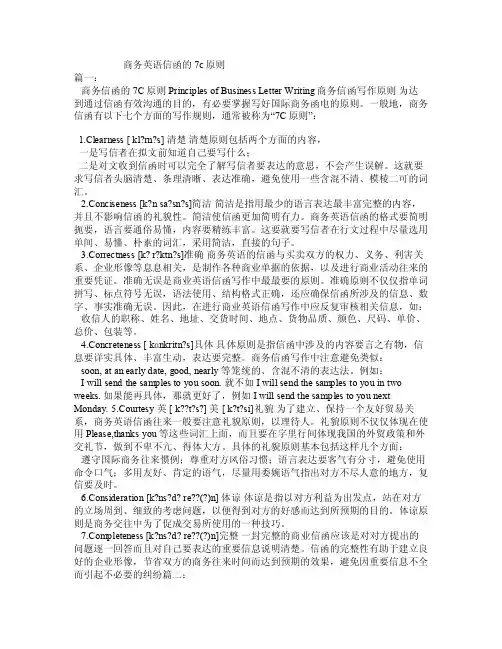
商务英语信函的7c原则篇一:商务信函的7C原则 Pr incip les o f Bus iness Lett er Wr iting商务信函写作原则为达到通过信函有效沟通的目的,有必要掌握写好国际商务函电的原则。
一般地,商务信函有以下七个方面的写作规则,通常被称为“7C原则”:1.Clear ness[ kl?rn?s]清楚清楚原则包括两个方面的内容,一是写信者在拟文前知道自己要写什么;二是对文收到信函时可以完全了解写信者要表达的意思,不会产生误解。
这就要求写信者头脑清楚、条理清晰、表达准确,避免使用一些含混不清、模棱二可的词汇。
2.Con cisen ess [k?n s a?sn?s]简洁简洁是指用最少的语言表达最丰富完整的内容,并且不影响信函的礼貌性。
简洁使信函更加简明有力。
商务英语信函的格式要简明扼要,语言要通俗易懂,内容要精练丰富。
这要就要写信者在行文过程中尽量选用单间、易懂、朴素的词汇,采用简洁,直接的句子。
3.Co rrect ness[k? r?ktn?s]准确商务英语的信函与买卖双方的权力、义务、利害关系、企业形像等息息相关,是制作各种商业单据的依据,以及进行商业活动往来的重要凭证。
准确无误是商业英语信函写作中最最要的原则。
准确原则不仅仅指单词拼写、标点符号无误,语法使用、结构格式正确,还应确保信函所涉及的信息、数字、事实准确无误。
因此,在进行商业英语信函写作中应反复审核相关信息,如:收信人的职称、姓名、地址、交货时间、地点、货物品质、颜色、尺码、单价、总价、包装等。
4.C oncre tenes s [ kɑnkri tn?s]具体具体原则是指信函中涉及的内容要言之有物,信息要详实具体、丰富生动,表达要完整。
7c原则在商务英语函电中的应用
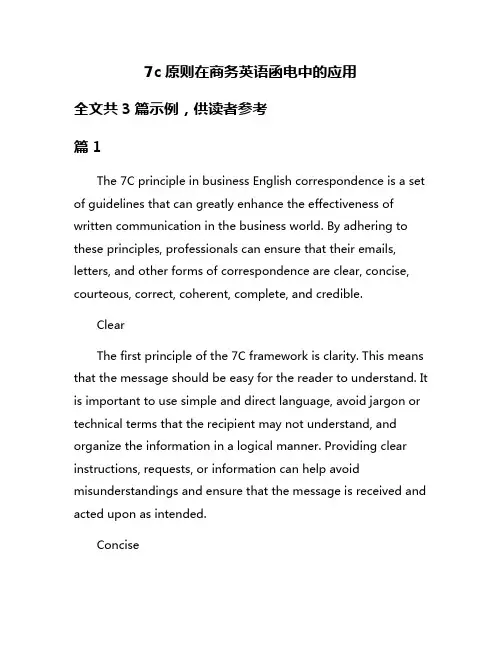
7c原则在商务英语函电中的应用全文共3篇示例,供读者参考篇1The 7C principle in business English correspondence is a set of guidelines that can greatly enhance the effectiveness of written communication in the business world. By adhering to these principles, professionals can ensure that their emails, letters, and other forms of correspondence are clear, concise, courteous, correct, coherent, complete, and credible.ClearThe first principle of the 7C framework is clarity. This means that the message should be easy for the reader to understand. It is important to use simple and direct language, avoid jargon or technical terms that the recipient may not understand, and organize the information in a logical manner. Providing clear instructions, requests, or information can help avoid misunderstandings and ensure that the message is received and acted upon as intended.ConciseBeing concise means getting straight to the point and avoiding unnecessary information. In business communication, time is often of the essence, so it is best to keep emails and letters brief and to the point. This can help the reader quickly grasp the main message and take the necessary action without being overwhelmed by irrelevant details.CourteousCourtesy is essential in all forms of communication, but it is especially important in business correspondence. Being polite, respectful, and considerate when writing emails or letters can help maintain a positive relationship with the recipient and ensure that the message is received in a favorable light. Simple expressions of courtesy, such as saying please and thank you, can go a long way in fostering good relationships with clients, customers, and colleagues.CorrectAccuracy is crucial in business communication. Spelling, grammar, and punctuation errors can make the writer appear unprofessional and can detract from the credibility of the message. Before sending any correspondence, it is important to proofread carefully to ensure that there are no mistakes.Double-checking facts, figures, and other information can also help prevent errors and misunderstandings.CoherentCoherence means that the message is well-organized and flows logically from one point to the next. This involves structuring the information in a clear and logical manner, using headings and bullet points to highlight important points, and ensuring that there is a clear progression from introduction to conclusion. A coherent message is easier for the reader to follow and is more likely to achieve the desired outcome.CompleteIn business correspondence, it is important to provide all the necessary information the recipient needs to understand the message and take the appropriate action. This means including relevant details, such as dates, times, and locations, and providing any supporting documents or attachments that may be necessary. Failing to provide complete information can lead to confusion and delays in communication.CredibleFinally, credibility is essential in business communication. This means that the writer should be honest, reliable, andtrustworthy in all communications. Making false statements, exaggerating claims, or withholding important information can damage the writer's reputation and harm the trust that the recipient has in the sender. By being transparent and truthful, professionals can build and maintain credibility with clients, customers, and colleagues.In conclusion, the 7C principle is a valuable tool for enhancing the effectiveness of business English correspondence. By following these guidelines, professionals can ensure that their messages are clear, concise, courteous, correct, coherent, complete, and credible, leading to more successful communication and better outcomes in the business world.篇2The 7C principle in business English correspondence is a set of guidelines that helps to ensure effective communication in written communication. The 7 Cs are: clarity, completeness, conciseness, coherence, correctness, courtesy, and consideration.Clarity is the first and most important principle in business English correspondence. It is essential to be clear and to thepoint in order to avoid any misunderstanding. Use simple and straightforward language to convey your message.Completeness refers to providing all necessary information in your correspondence. Make sure to include all relevant details and answer any questions that may arise. Leaving out important information can lead to confusion and unnecessaryback-and-forth communication.Conciseness is the ability to convey your message in a clear and concise manner. Avoid using unnecessary words or jargon that may confuse the reader. Keep your correspondence brief and to the point.Coherence is the principle of organizing your thoughts in a logical and structured manner. Make sure that your correspondence flows smoothly and that your ideas are presented in a coherent and understandable way.Correctness is essential in business English correspondence. Make sure to use correct grammar, punctuation, and spelling. Mistakes can make you look unprofessional and can lead to misunderstandings.Courtesy is important in business communication. Always be polite and respectful in your correspondence. Use appropriate language and tone to show respect for the recipient.Consideration is the final principle of the 7C principle. Always consider the needs and expectations of the recipient when writing your correspondence. Think about how your message will be received and make sure to address any concerns or questions that may arise.In conclusion, the 7C principle is a valuable tool for ensuring effective communication in business English correspondence. By following these guidelines, you can improve the clarity, completeness, conciseness, coherence, correctness, courtesy, and consideration of your written communication. By applying these principles, you can enhance your professional image and build better relationships with your business partners and clients.篇3The 7C principle is a fundamental concept in business communication that highlights seven key elements required for effective communication in written correspondence. The principles - Clear, Concise, Complete, Correct, Courteous, Considerate, and Concrete - are essential for ensuring thatbusiness letters, emails, and other types of formal communication are well received and understood by the recipients.Clear: Clarity is crucial in business communication to avoid any misinterpretation or confusion. The message should be straightforward and easy to understand, using simple language and avoiding jargon or technical terms that the recipient may not be familiar with.Concise: Business communication should be concise and to the point, conveying the necessary information without unnecessary details or lengthy sentences. This helps in keeping the reader engaged and focused on the key message of the correspondence.Complete: The communication should be complete, providing all the necessary information that the recipient needs to know. This includes relevant details, background information, and any supporting documents or attachments that may be required.Correct: Accuracy is essential in business communication to maintain credibility and professionalism. The correspondence should be free of grammatical errors, spelling mistakes, and typos that can detract from the message.Courteous: Etiquette plays a crucial role in business communication, and it is important to be polite and respectful towards the recipient. Using polite language, addressing the recipient by their name, and expressing appreciation or gratitude when necessary can help in building positive relationships.Considerate: It is important to consider the needs and interests of the recipient when composing business correspondence. This includes tailoring the message to the recipient's preferences, providing relevant information, and anticipating any questions or concerns that they may have.Concrete: The communication should be specific and focused, providing concrete details and examples to support the message. Using facts, figures, and examples can help in making the message more persuasive and convincing.In the context of business English correspondence, the 7C principle can be applied to various types of communication, including letters, emails, memos, and reports. Whether you are writing a business proposal, responding to a customer inquiry, or following up on a meeting, following the 7C principle can help in ensuring that your message is clear, concise, and effective.For example, when writing a business email to a potential client, you should ensure that your message is clear and to thepoint, providing all the necessary information about your products or services. It should be concise, avoiding unnecessary details or lengthy explanations, and it should be correct in terms of grammar, spelling, and punctuation.Moreover, you should be courteous and considerate in your email, using polite language and showing respect towards the recipient. You should also be concrete in your communication, providing specific examples and details to support your claims and make your message more persuasive.In conclusion, the 7C principle is a valuable guideline for effective communication in business English correspondence. By following these seven principles - Clear, Concise, Complete, Correct, Courteous, Considerate, and Concrete - you can ensure that your written communication is professional, effective, and well-received by the recipients.。
商务英语写作7c原则
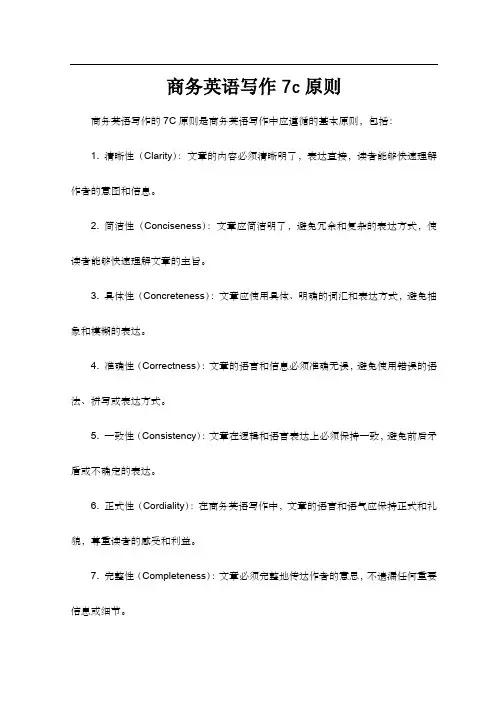
商务英语写作7c原则
商务英语写作的7C原则是商务英语写作中应遵循的基本原则,包括:
1. 清晰性(Clarity):文章的内容必须清晰明了,表达直接,读者能够快速理解作者的意图和信息。
2. 简洁性(Conciseness):文章应简洁明了,避免冗余和复杂的表达方式,使读者能够快速理解文章的主旨。
3. 具体性(Concreteness):文章应使用具体、明确的词汇和表达方式,避免抽象和模糊的表达。
4. 准确性(Correctness):文章的语言和信息必须准确无误,避免使用错误的语法、拼写或表达方式。
5. 一致性(Consistency):文章在逻辑和语言表达上必须保持一致,避免前后矛盾或不确定的表达。
6. 正式性(Cordiality):在商务英语写作中,文章的语言和语气应保持正式和礼貌,尊重读者的感受和利益。
7. 完整性(Completeness):文章必须完整地传达作者的意思,不遗漏任何重要信息或细节。
这些原则是商务英语写作中应遵循的基本准则,可以帮助作者更好地表达自己的意图,提高文章的可读性和理解性,同时也可以建立良好的商业形象和信誉。
商务英语信函写作7c原则范文开头
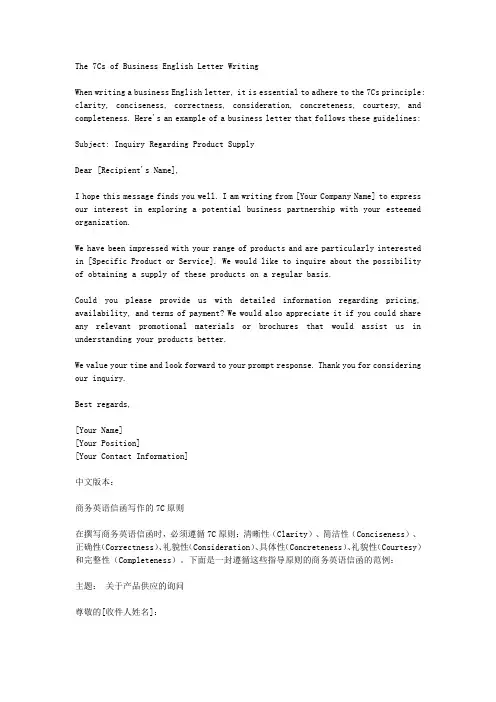
The 7Cs of Business English Letter WritingWhen writing a business English letter, it is essential to adhere to the 7Cs principle: clarity, conciseness, correctness, consideration, concreteness, courtesy, and completeness. Here's an example of a business letter that follows these guidelines:Subject: Inquiry Regarding Product SupplyDear [Recipient's Name],I hope this message finds you well. I am writing from [Your Company Name] to express our interest in exploring a potential business partnership with your esteemed organization.We have been impressed with your range of products and are particularly interested in [Specific Product or Service]. We would like to inquire about the possibility of obtaining a supply of these products on a regular basis.Could you please provide us with detailed information regarding pricing, availability, and terms of payment? We would also appreciate it if you could share any relevant promotional materials or brochures that would assist us in understanding your products better.We value your time and look forward to your prompt response. Thank you for considering our inquiry.Best regards,[Your Name][Your Position][Your Contact Information]中文版本:商务英语信函写作的7C原则在撰写商务英语信函时,必须遵循7C原则:清晰性(Clarity)、简洁性(Conciseness)、正确性(Correctness)、礼貌性(Consideration)、具体性(Concreteness)、礼貌性(Courtesy)和完整性(Completeness)。
商务英语信函的7C原则
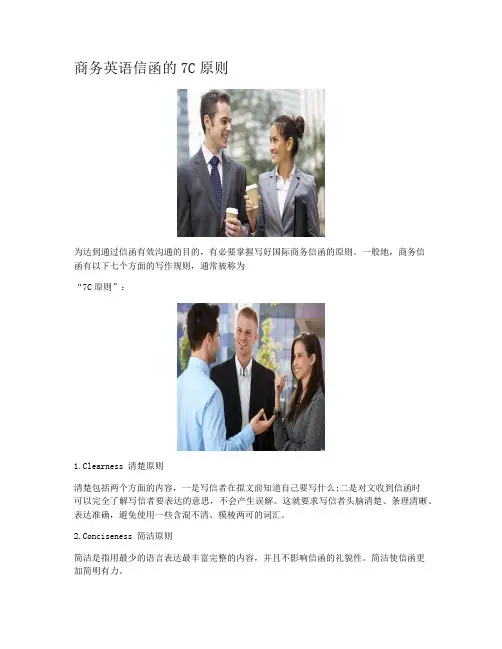
商务英语信函的7C原则为达到通过信函有效沟通的目的,有必要掌握写好国际商务信函的原则。
一般地,商务信函有以下七个方面的写作规则,通常被称为“7C原则”:1.Clearness 清楚原则清楚包括两个方面的内容,一是写信者在拟文前知道自己要写什么;二是对文收到信函时可以完全了解写信者要表达的意思,不会产生误解。
这就要求写信者头脑清楚、条理清晰、表达准确,避免使用一些含混不清、模棱两可的词汇。
2.Conciseness 简洁原则简洁是指用最少的语言表达最丰富完整的内容,并且不影响信函的礼貌性。
简洁使信函更加简明有力。
商务英语信函的格式要简明扼要,语言要通俗易懂,内容要精练丰富。
这要就要写信者在行文过程中尽量选用简单、易懂、朴素的词汇,采用简洁,直接的句子商务英语信函的“7C原则”商务英语信函的“7C原则”。
3.Correctness 准确原则商务英语的信函与买卖双方的权力、义务、利害关系、企业形像等息息相关,是制作各种商业单据的依据,以及进行商业活动往来的重要凭证。
准确无误是商业英语信函写作中最最要的原则。
准确原则不仅仅指单词拼写、标点符号无误,语法使用、结构格式正确,还应确保信函所涉及的信息、数字、事实准确无误。
因此,在进行商业英语信函写作中应反复审核相关信息,如:收信人的职称、姓名、地址、交货时间、地点、货物品质、颜色、尺码、单价、总价、包装等。
4.Concreteness 具体原则具体原则是指信函中涉及的内容要言之有物,信息要详实具体、丰富生动,表达要完整。
商务信函写作中注意避免类似:soon, at an early date, good, nearly 等笼统的、含混不清的表达法。
例如:I will send the samples to you soon. 就不如 I will send the samples to you in two weeks. 如果能再具体,那就更好了,例如 I will send the samples to you next Monday.5.Courtesy 礼貌原则为了建立、保持一个友好贸易关系,商务英语信函往来一般要注意礼貌原则,以理待人。
商务信函原则
竭诚为您提供优质文档/双击可除商务信函原则篇一:商务信函的7c原则principlesofbusinessLetterwriting商务信函写作原则为达到通过信函有效沟通的目的,有必要掌握写好国际商务函电的原则。
一般地,商务信函有以下七个方面的写作规则,通常被称为“7c原则”:1.clearness[kl?rn?s]清楚清楚原则包括两个方面的内容,一是写信者在拟文前知道自己要写什么;二是对文收到信函时可以完全了解写信者要表达的意思,不会产生误解。
这就要求写信者头脑清楚、条理清晰、表达准确,避免使用一些含混不清、模棱二可的词汇。
2.conciseness[k?nsa?sn?s]简洁简洁是指用最少的语言表达最丰富完整的内容,并且不影响信函的礼貌性。
简洁使信函更加简明有力。
商务英语信函的格式要简明扼要,语言要通俗易懂,内容要精练丰富。
这要就要写信者在行文过程中尽量选用单间、易懂、朴素的词汇,采用简洁,直接的句子。
3.correctness[k?r?ktn?s]准确商务英语的信函与买卖双方的权力、义务、利害关系、企业形像等息息相关,是制作各种商业单据的依据,以及进行商业活动往来的重要凭证。
准确无误是商业英语信函写作中最最要的原则。
准确原则不仅仅指单词拼写、标点符号无误,语法使用、结构格式正确,还应确保信函所涉及的信息、数字、事实准确无误。
因此,在进行商业英语信函写作中应反复审核相关信息,如:收信人的职称、姓名、地址、交货时间、地点、货物品质、颜色、尺码、单价、总价、包装等。
4.concreteness[kɑnkritn?s]具体具体原则是指信函中涉及的内容要言之有物,信息要详实具体、丰富生动,表达要完整。
商务信函写作中注意避免类似:soon,atanearlydate,good,nearly等笼统的、含混不清的表达法。
例如:Iwillsendthesamplestoyousoon.就不如Iwillsendthesamplestoyouintwoweeks.如果能再具体,那就更好了,例如Iwillsendthesamplestoyounextmonday.5.courtesy英[k??t?s?]美[k?t?si]礼貌为了建立、保持一个友好贸易关系,商务英语信函往来一般要注意礼貌原则,以理待人。
商务英语写作中的7C原则
汇报人:
目录
CONTENTS
商务英语写作是一种跨文化交流方式 商务英语写作是商务沟通的重要手段 商务英语写作需要遵循一定的规范和标准 商务英语写作需要注重语言的选择和运用
促进国际贸易交流:商务英语写作是国际商务交流的重要手段,能够促进 国际贸易的发展和合作。
明确主题:在开始写作之前, 要明确文章的主题和目的, 确保读者能够理解并关注文
章的核心内容。
简洁明了:避免使用复杂的 词汇和句子结构,使用简单、 直接的语言进行表达,让读
者能够快速理解。
清晰结构:采用Leabharlann 晰的结构 和段落划分,使文章更加易
于阅读和理解。
具体细节:提供具体、详细 的例子和数据,以支持文章 的观点和论点,使读者更加 信任并理解文章的内容。
• * 错误示例:没有使用适当的结束语,如“Best regards”或“Sincerely”等 • * 正确示例:使用适当的结束语,表达敬意和感谢,同时署名并注明日期
• 案例四:附件的使用 * 错误示例:没有提供必要的附件或提供的附件与邮件内容不相关 * 正确示例:提供必要的附 件,并与邮件内容相关,同时注明附件的名称和内容
• 案例二:邮件正文中的措辞 * 错误示例:使用过于直接或粗鲁的措辞,缺乏礼貌和尊重 * 正确示例:使用礼貌、尊 重和友好的措辞,避免使用冒犯性或攻击性的言辞
• * 错误示例:使用过于直接或粗鲁的措辞,缺乏礼貌和尊重 • * 正确示例:使用礼貌、尊重和友好的措辞,避免使用冒犯性或攻击性的言辞
• 案例三:邮件结尾的使用 * 错误示例:没有使用适当的结束语,如“Best regards”或“Sincerely”等 * 正确示例: 使用适当的结束语,表达敬意和感谢,同时署名并注明日期
剑桥商务英语写作7C原则
剑桥商务英语写作7C原则2016年剑桥商务英语写作7C原则剑桥商务英语写作有著名的7C原则:Clarity清楚、Correctness 准确、conciseness简洁、completeness完整、courtesy礼貌、concreteness具体、consideration体贴。
下面就和yjbys网店铺一起来了解下吧!注意:在商务函件中,传达的内容和传达的方式同等重要。
原则一Concreteness 具体尽量使用明确、具体的词汇。
这样你的信函将更为专业、准确、有趣并且有力。
(由于有时需要使用某种外交手段,可能会反其道而行之。
)原则二Clarity 清楚“清楚”在于“在正确的场合使用正确的词汇”,具体而言:1 使用短小、熟悉并且在会话中经常使用的.词汇,然后将其有效地组句成段。
2 一句话不要讲述过多的思想,一句话最多讲一个点。
3 每句话不超过17-20个词。
4 如果情况允许,可以使用一些直观辅助,像举个栗子、做个图表等等。
原则三Correctness 准确“准确”指没有错误:即数据、陈述和意见都准确清晰。
此外,“准确”还指撰写人在拼写、语法、标点以及格式上都没有问题。
试一试完善以下例句~1.Well chosen words are likely to be short and natural words.2.The principals of effective letters and memorandums are similiar.3.An efficient and concerned personal department builds employee morale.4.The box, together with the baskets, were sent to theshipping room.5.Jim and Paul are good friends of Mary and I.6.In countries where two or more languages co-exist confusion often arises.改善~1.Well-chosen words are likely to be short and natural words.2.The principles of effective letters and memorandums are similar.* principle3.An efficient and concerned Personnel Department builds employee morale.* Personnel4.The box, together with the baskets, was sent to the shipping room.5.Jim and Paul are good friends of Mary and me.6.In countries where two or more languages co-exist, confusion often arises.原则四Conciseness 简洁简洁指在不违背其他C原则的前提下尽量使用最少的的词汇来表达自己的意思。
商务英语信函7c写作原则
竭诚为您提供优质文档/双击可除商务英语信函7c写作原则篇一:商务信函的7c原则principlesofbusinessLetterwriting商务信函写作原则为达到通过信函有效沟通的目的,有必要掌握写好国际商务函电的原则。
一般地,商务信函有以下七个方面的写作规则,通常被称为“7c原则”:1.clearness[kl?rn?s]清楚清楚原则包括两个方面的内容,一是写信者在拟文前知道自己要写什么;二是对文收到信函时可以完全了解写信者要表达的意思,不会产生误解。
这就要求写信者头脑清楚、条理清晰、表达准确,避免使用一些含混不清、模棱二可的词汇。
2.conciseness[k?nsa?sn?s]简洁简洁是指用最少的语言表达最丰富完整的内容,并且不影响信函的礼貌性。
简洁使信函更加简明有力。
商务英语信函的格式要简明扼要,语言要通俗易懂,内容要精练丰富。
这要就要写信者在行文过程中尽量选用单间、易懂、朴素的词汇,采用简洁,直接的句子。
3.correctness[k?r?(:商务英语信函7c写作原则)ktn?s]准确商务英语的信函与买卖双方的权力、义务、利害关系、企业形像等息息相关,是制作各种商业单据的依据,以及进行商业活动往来的重要凭证。
准确无误是商业英语信函写作中最最要的原则。
准确原则不仅仅指单词拼写、标点符号无误,语法使用、结构格式正确,还应确保信函所涉及的信息、数字、事实准确无误。
因此,在进行商业英语信函写作中应反复审核相关信息,如:收信人的职称、姓名、地址、交货时间、地点、货物品质、颜色、尺码、单价、总价、包装等。
4.concreteness[kɑnkritn?s]具体具体原则是指信函中涉及的内容要言之有物,信息要详实具体、丰富生动,表达要完整。
商务信函写作中注意避免类似:soon,atanearlydate,good,nearly等笼统的、含混不清的表达法。
例如:Iwillsendthesamplestoyousoon.就不如Iwillsendthesamplestoyouintwoweeks.如果能再具体,那就更好了,例如Iwillsendthesamplestoyounextmonday.5.courtesy英[k??t?s?]美[k?t?si]礼貌为了建立、保持一个友好贸易关系,商务英语信函往来一般要注意礼貌原则,以理待人。
- 1、下载文档前请自行甄别文档内容的完整性,平台不提供额外的编辑、内容补充、找答案等附加服务。
- 2、"仅部分预览"的文档,不可在线预览部分如存在完整性等问题,可反馈申请退款(可完整预览的文档不适用该条件!)。
- 3、如文档侵犯您的权益,请联系客服反馈,我们会尽快为您处理(人工客服工作时间:9:00-18:30)。
Correctness (准确)
例句
Should any of the items is of interest to you, please let us know.
Should any of the items be of interest to you, please let us know.
例句
Quote us the most reasonable price. (给我方报最合理的价格)
Will you please quote us the most reasonable price?
Clarity (清晰)
Clarity means your purpose and the words are clear to your readers so that the recipients can interpret your words with the same meaning you have in mind.
Case Studies (案例分析)
We have received with thanks your check. The amount has been placed to your credit.
我们已经收到你方支票,谢谢。该笔款 项已汇入你账户贷方。
提示: 违背了“具体”(Concreteness)原则
Your Try(思考题)
1. We are given to understand you are able to supply large quantities at more attractive prices. Hint: violates the clarity principle (违反了清晰原则) 2. We have the pleasure of acknowledging your letter of April 4. Hint: violates the conciseness principle(违反了简洁原则) 3. In view of you are our regular customers, we agree to your request for price reduction. Hint: violates the correctness principle(违反了准确原则)
你方7月1日的函收悉。
提示: 违背了“简洁”(Conciseness)原则
Case Studies (案例分析)
Because our book is full, so we cannot entertain any more orders.
由于我方订货已满,恕不能接受更多的 订单。
提示: 违背了“准确”(Correctness)原则
Concreteness means the writing should be specific, definite and vivid rather than vague, general and abstract.
Concreteness (具体)
例句
a significant loss a 53 percent loss in the near future by Thursday afternoon the majority 70 percent
微课名称:商务英语写作中的7C原则 所属课程:高级商务英语写作 主讲教师:李更春 单位:浙江广播电视大学外国语学院
教学目标
知识目标
学会在信函写作中运 用7C原则
技能目标
了解商务信函写作中
的7C原则
技能目标
学会站在他人的角度 考虑问题
学会运用7C原则对商
务信函进行评价
情感目标
请同学们思考,在商务信函的写作中,我们应遵循 哪些原则呢?
Conciseness (简洁)
例句
We have begun to export our machines to the foreign countries. (我 们已经开始向国外出口机器了)
We have begun to export our machines.
Business writing should be correct in grammar, punctuation, spelling, information, figures, etc.
正式 (formal)
迂回 (winded)
清晰 (clear)
详尽
具体
(detailed) ( concrete)
笼统 (general)
简洁
完整
(concise) (complete)
简短 (short)
逻辑 (logical)
准确
礼貌
有力
体谅
(correct) (courteous) (forceful) (considerate)
7C principles
CCoonnssiiddeerraattiioonn ((体体谅谅))
CCoouurrtteessyy ((礼礼貌貌))
CCllaarriittyy ((清清晰晰))
Conciseness (简洁)
Correctness (准确)
Concreteness (具体)
Completeness (完整)
Consideration (体谅)
例句
We allow you a 2% discount for cash payment. (如付现款,我们给九八折)
You earn a 2% discount when you pay cash.
Courtesy (礼貌)
Courtesy is an important feature of business correspondence. In fact, it is an essential element of any successful communication, whether it is written or spoken.
Conciseness means to write the fewest possible words without sacrificing completeness and courtesy. By eliminating unnecessary words, you
help make important ideas stand out.
1 with consideration for its
recipients
2 be courteous towards
them
4 be correct in grammar, spelling, punctuation, and figures
3 be clear in meaning
5 6 be concise and concrete in wording and be complete in format, structure, and info
请尽快告知,你方希望我方就此事做些 什么? or 请告知,你方希望我方就此事尽 快做些什么?
提示: 违背了“清晰”(Clarity)原则
Case Studies (案例分析)
We acknowledge with thanks the receipt of your letter of July 1.
Consideration means that you prepare the writing with the readers in mind, and try to put yourself in his place to indicate that you are considerate.
例句
As to the streamers sailing from Shanghai to New York, we have bimonthly direct services. (从上海到纽约有直达船) We have a direct sailing from Shanghai to New York every two months.
ห้องสมุดไป่ตู้
谢谢观看
例句
As to the streamers sailing from Shanghai to New York, we have bimonthly direct services. (从上海到纽约有直达船) We have two direct sailings every month from Shanghai to New York.
As to information, the writer should strive to make all points detailed, and answer all questions asked or implied.
Summary: A letter should be written
Your Try(思考题)
4. Please airmail us the latest price list and sample for our reference. Hint: violates the courtesy principle(违反了礼貌原则) 5. We request you to open the covering L/C as soon as possible. Hint: violates the consideration principle(违反了体谅原则) 6. Please extend the L/C for ten days. Hint: violates the concreteness principle(违反了具体原则)
Case Studies (案例分析)
